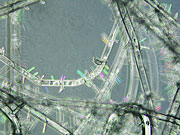- Number 332 |
- March 7, 2011
Molecules are sensitive to their surroundings

Diffraction studies provided
the insights needed to
understand key molecules
in hydrogen storage.
For nearly a century, nobody knew how the little molecule that’s in the middle of many of today’s hydrogen storage and release concepts was organized. Thanks to an interdisciplinary team of scientists at DOE’s Pacific Northwest National Laboratory and Los Alamos National Laboratory, the structure of this molecule, known as DADB, has been determined. And DADB’s structure was exactly opposite of what was expected in more ways than one.
“The irony,” said Dr. Tom Autrey, the PNNL scientist who led the research, “is that the structure could not be that complex.” The challenge was in understanding how one structure, containing a pair of nitrogen and boron atoms surrounded by only 12 hydrogen atoms, stretched and twisted in the solid molecular crystal.
Storing and retrieving energy in chemical bonds such as the hydrogen in DADB is critical for ballasting energy demands from intermittent wind and solar power sources. Additionally, understanding the subtleties of the DADB structure provides insights into developing novel catalyst materials for hydrogen activation. DOE’s Office of Basic Energy Sciences funded this research, which was done in EMSL and the Manuel Lujan Jr. Center.
[Kristin Manke, 509.372.6011,
kristin.manke@pnl.gov]
